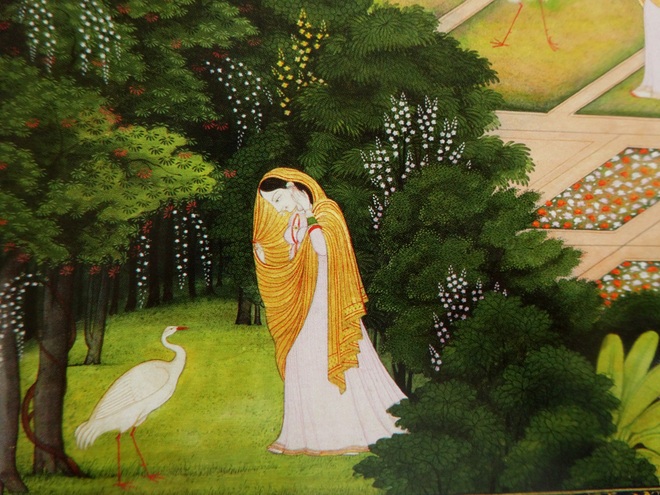
LOVE BLOSSOMS: Damayanti listening to the Swan. Detail of a folio from the Nala-Damayanti series. Pahari, ca. 1775; from the collection of Dr Karan Singh at Jammu.
BN Goswamy
Karkotasya naagasya Damayantyaa Nalasya cha
Rituparnasya rajarashe kirtanam Kali-naashanam
[Reciting the story of Karkotaka, the serpent, of Damayanti and Nala, and of the royal sage, King Rituparna, destroys the evil effects of the Kali age.]
— From the Nalopakhyana in the Mahabharata
Nala and Damayanti, their passionate union and their unfortunate separation; in the course of that their trials and their tribulations; and, finally, the end of their troubles and their reunion — finds its place in the great epic, the Mahabharata. And the point of it being told there by a visiting sage, even though it has nothing directly to do with the ongoing conflict between the Pandavas and the Kauravas, is didactic.

Things are bad now, the sage tells Yudhishthira, the seniormost of the Pandavas, but they will turn. Another noble king had, in the past, suffered at the hands of ‘outrageous fortune’, losing his entire kingdom at the throw of dice, but all this will change.
Damayanti, the sage tells the Pandavas, was the daughter of King Bhima of Vidarbha who announced her svayamvara at which she could choose a husband for herself.
The fame of her beauty and her nature having spread far and wide, kings and princes of all hues, even the gods — including Indra, Agni, Varuna and Yama — and guardians of the quarters, flocked together to that ceremony. But Damayanti had already fallen in love with young Nala, king of Nishadha, through the mediation of a golden swan — hamsa is the term used — who acted as a messenger between them.
At the svayamvara, Damayanti chose Nala, even though the four gods had tried to play upon her an elaborate ruse trying to trick her into choosing one of them. Their heart’s desire granted, Nala and Damayanti got married and spent long years in great felicity. But then fate struck.

The spirit of the evil age, Kali, who had also been a contender for Damayanti’s hand, had decided to avenge himself upon the young couple. He planned and he plotted and succeeded in separating the two, each of them going through untold suffering. Finally, however, all this ended. Nala, having lost his kingdom at one point to his own brother in a game of dice earlier, recovered everything: his kingdom, his lost wife, and his peace: all through having learnt from a kindly king who had employed him as his charioteer, all the intricacies of that game of dice. Having narrated this uplifting account, the sage departed, adding that the mere recitation of this tale destroys all sins.

Frontispiece to the ‘Nala-Damajanti’ book by Ruckert. 1845.
Whether for the destruction of sins, or for savouring its sheer charm, the tale of Nala and Damayanti entered countless texts of early India. Even in that other great epic, the Ramayana, it finds mention. In the Samhitas, and Brahmanas, of old; in the Puranas ranging from the Padma and the Linga, to the Vayu and the Matsya, one finds it in one version or the other. Those great repositories of tales, like the Brihat-katha, and the Kathasaritasagara, feature it. This apart, independent texts devoted wholly to the tale — like the Nalachampu of Trivikram Bhatta, the Naishadhananda of Kshemeshvara, the Davadantikatha of Jinasagara Suri, the Nalaramayana of Rajashekhara — came to be written. The charm of the story seems to have been irresistible. Even the famous German poet, Friederick Ruckert, succumbed to it, for he translated the entire text from Sanskrit into German verse and published it in the 1840s, including in it an illustration of a European-looking Damayanti listening to the Swan delivering her lover’s message. All this apart, several series of paintings, or illustrated manuscripts, centering upon it, were commissioned by Indian connoisseurs, in styles ranging from the pre-Rajasthani and the popular Mughal to the Deccani. But perhaps the most outstanding of paintings of the Nala-Damayanti theme came out of the Pahari area. In the hands of a painter of the celebrated artist-family headed by Pandit Seu, based in Guler, the tale sprang to life like nowhere else. There are paintings in that series — now for the most part in the Karan Singh collection in Jammu — as also incredibly refined drawings scattered over different collections. In these the painter sets out to search for the ultimate in the expression of delicacy of feeling. Every situation, each detail, is told as if in a soft whisper. How Damayanti hears from wandering minstrels of the beauty and the nature of Nala and falls in love with him; how a golden swan captured by Nala in his garden is released because it promises to fly to Damayanti in her distant home and speak to her of Nala’s nobility and his love for her; how the love of the two grows by the day, in fact by the moment even though they have not met yet; and how Nala wins her hand in the svayamvara, are all there in this extraordinary series. Here, Damayanti swoons at the mere thought of her lover, the gods fall hopelessly in love with her, Nala turns invisible as he enters his beloved’s apartment, and all this time that golden swan keeps an eye out for the pair. There is a wispy softness of line in these paintings; the brush appears barely to touch the surface of paper, and forms look as if they have just been ‘breathed’ upon paper.
It is not easy to pick just one work from the series to speak about. But — purely for the sheer refinement of it all — one could look at the folio where the swan lands in Damayanti’s garden for the first time. Discreetly, she leaves her bevy of friends and goes quietly into a small grove to be able to speak with the swan, or hear it, all by herself. Damayanti listens with great care, hanging on every word, but even as she listens, out of sheer shyness, she pulls a veil towards her face, for it is her great love’s words that are being conveyed to her. This simple, but moving, gesture seems to say it all. When the painter Raja Ravi Varma turned to this tale, what moment from it did he pick? Damayanti’s conversation with the swan, the theme being selected later for a postage stamp. The props, the dresses, the postures, all came out of his theatrical cupboard, so to speak, but the moment is well chosen. And when the contemporary photographer, Venket Ram, turns to re-creating with his lens ‘scenes’ from Ravi Varma’s old paintings, what does he do? One of the images he picks is ‘Damayanti and the Swan’, dresses up Ramya Krishnan, that talented film actress from the south, as Damayanti, and clicks.
Evidently, a tale for all times and all seasons.
Join Whatsapp Channel of The Tribune for latest updates.



























